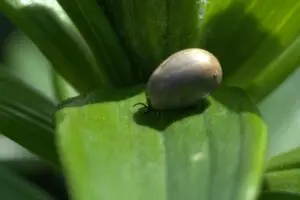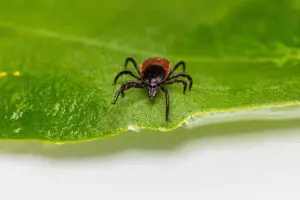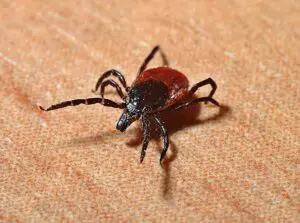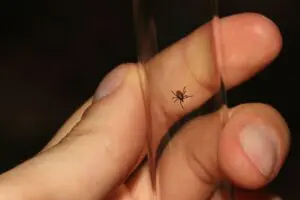
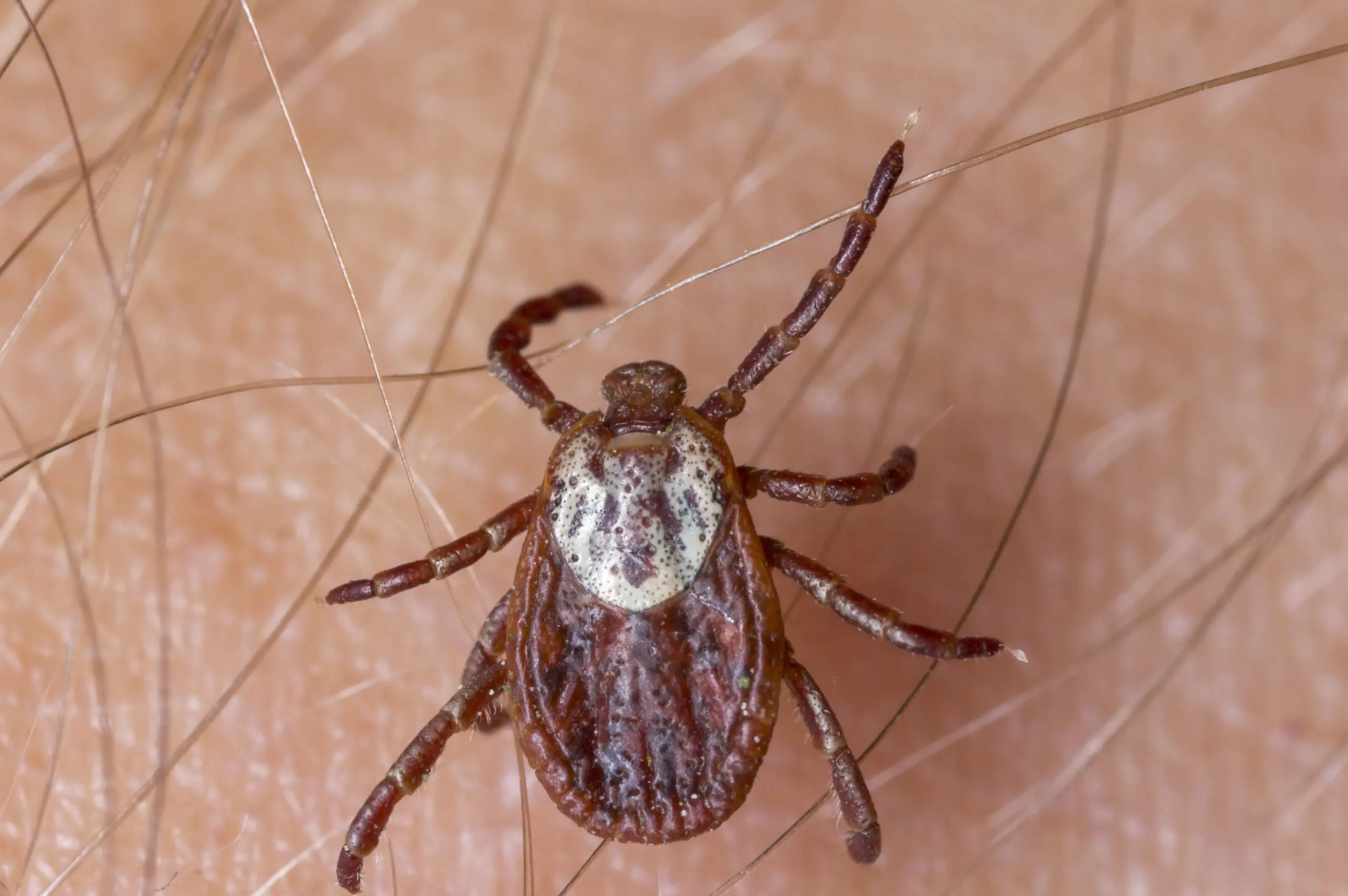
It’s that time of year again- peak tick season in Florida. Yay! Seriously though, none of us like seeing ticks, especially not on us. So, to help you avoid as many ticks as possible this spring and summer, here’s a guide on when Florida ticks are most active, what hosts they like, types of ticks, and how to prevent them from biting.
When Is Tick Season in Florida?
Technically, tick season in Florida is year-round. According to the Florida Department of Health, diseases caused by tick bites are more likely to occur during spring and summer. That being said, ticks are active throughout the year in Florida. The abundance of nymphs and adults varies by season and species. Both nymphs and adults can transmit diseases, so it is important to remove ticks promptly no matter how mature they are. Oftentimes, nymphs are small enough to go unnoticed for long periods of time, meaning they pose an increased risk of disease transmission. In order to avoid disease transmission from nymphs and adults alike, it is important to practice prevention and regular checks on you, your family, and your pets.
Types of Ticks in Florida
There are several different types of ticks, each with unique characteristics and habits. Understanding the different types of ticks can help you take the necessary precautions to avoid being bitten and contracting tick-borne illnesses.
American Dog Ticks
As their name suggests, adult American dog ticks prefer to attach to dogs. They will feed on humans or other mammals if they need to, though. Nymphs mainly feed on rodents, like mice and rats. Nymphs are most active from January to March, when they become adults. Adults are most active from March to September. American dog ticks are known to carry Rocky Mountain spotted fever. This species produces a toxic secretion that can cause paralysis in dogs and children when a tick attaches to the base of the skull or the spinal column. The paralysis will typically cease within 24 hours after the tick’s removal.
Brown Dog Tick
Like American dog ticks, adult brown dog ticks prefer canine hosts and are typically found in areas where there are abundances of dogs, like kennels and dog parks. Brown dog ticks do not really have a peak season, and they are steadily active year-round. This is likely because of the fact that this species can complete its entire life cycle either indoors or outdoors. Most tick species need to complete some or all of their life cycle outdoors. Because of their unique ability, brown dog ticks can infest kennels, homes, and any other indoor area where at least one dog is available as a host. According to the CDC, brown dog ticks have been found to be carriers of Rocky Mountain spotted fever in the southwestern part of the United States, as well as along the Mexican border.
Black-Legged Tick
Black legged ticks are more commonly known as deer ticks. Nymphs of this species feed on birds, rodents, and reptiles like snakes. Adults prefer larger animals, like deer or cattle, but they also like humans. Nymphs are most active from April to August, and adults are most active from September to May. Deer ticks in Florida are known for carrying Lyme disease, but they can also carry babesiosis and human granulocytic anaplasmosis, or HGA.
Gulf Coast Tick
Aptly named, these ticks are predominantly found in the Gulf Coast area of the United States, including Florida. Nymphs are most active from February to August, while adults are most active from March to November. Nymphs generally feed on small rodents, like mice, and ground birds, like terns. Adults will attach large animals and humans, and are usually found on the ears of larger mammals. Gulf Coast ticks carry a relative of Rocky Mountain spotted fever, called Rickettsia parkeri, which is less severe than RMSF.
Lone Star Tick
Of all the ticks in Florida, Lone Star ticks are the most common human-biting species. Female Lone Star ticks have a single, light colored dot on their backs- hence their name. Nymphs are most active from February to October. Adults are most active from April to August, with their peak being in July. Nymphs feed on birds and small mammals, but they do not bite rodents, and adults feed on large animals like deer, cattle, and humans. Lone Star ticks carry anaplasmosis, ehrlichiosis, and STARI, which stands for southern tick-associated rash illness.
Ticks on Pets in Florida
Florida ticks on dogs are common because they are a preferred host for many tick species. Common types of ticks in Florida, such as the American dog tick and brown dog tick, often latch onto dogs, putting them at risk for tick-borne diseases.
Regular tick checks, along with a Yard Protection Plan, can help reduce the tick population around your home.
Tick Bites in Florida
Tick bites in Florida are a significant health concern as they can transmit diseases. Florida ticks, especially nymphs, can go unnoticed due to their small size, increasing the risk of disease transmission. To learn more about tick-borne illnesses and symptoms, visit our Everything About Tick-Borne Diseases guide.
Do Ticks in Florida Carry Lyme Disease?
A common question is, "Do ticks in Florida have Lyme disease?" The black-legged tick, also known as the deer tick, can transmit Lyme disease, although cases are rarer in Florida compared to other states. For more on this topic, check out our Complete Guide to Ticks.
Prevention and Removal
Before any outdoor activities, apply an insect repellant that contains either DEET or permethrin. You can also treat your clothing with a clothing-only tick repellant that contains at least 0.5% permethrin. If you will be in a wooded area or an area with tall grass, wear long pants, a long sleeve shirt, and tall socks preferably all light in color. Light-colored clothing makes it easier to see ticks before they make it to the skin. Always check yourself, your family, and your pets for ticks after being outside, especially if you were in a wooded area or an area with tall grass.
If you find an attached tick, do not try to use alternative tick removal methods. Many of them do not work, and some are unnecessarily dangerous. To remove a tick, use tweezers to grab the tick as close to your skin as possible and gently pull it straight out- do not twist. Ideally, the entire tick will be removed, but occasionally the head detaches from the body and stays embedded in the skin. When this happens, the tick is dead and can no longer extract blood or transmit diseases. It may cause some skin irritation, but before too long, it will fall out on its own.
Hopefully this guide helps you have a tick-free season. If you’re seeing more ticks than usual around your property, though, give us a call and we’ll be happy to help. If you have any more questions regarding ticks, take a look at our tick FAQ page here.




